The 20-Second Trick For South African Culture Today
The 20-Second Trick For South African Culture Today
Blog Article
The South African Culture Today Statements
Table of ContentsSome Known Details About South African Culture Today How South African Culture Today can Save You Time, Stress, and Money.Some Of South African Culture TodayThe Ultimate Guide To South African Culture Today7 Simple Techniques For South African Culture TodayThe 7-Second Trick For South African Culture Today
This adheres to with vocal singing and drum pounding. The new bride and groom after that fulfill with the senior citizens and discuss the importance of their union. A matter of importance in Zambian villages is the passing away of enjoyed ones. All participants of the town placed cash, effort and time together for the interment of the deceased.Music and dancing is an extremely important aspect of the Zambian culture. The numerous tribal units have their very own dance forms; nonetheless, makishi is typical amongst all people.
Some Of South African Culture Today
When it comes to music, drums are used the most, with a variety of drumming events. In Zambia, majority of the individuals are Christian; Protestant and Roman Catholic. There are small groups of Muslims and Hindus, with the rest adhering to regional indigenous tribal ideas.

South African heritage and culture is immensely varied, and contains lots of different groups of individuals that each have their very own customs and ideas. Having such a diversity of individuals and societies is what makes South Africa so special. In the real sense of the expression, we are a rainbow country.
Making it the 7th on the checklist of countries with the most Portuguese individuals in it outside of Portugal. Portuguese is not only a society, however it is also a language and a citizenship. Portuguese people stem from the nation of Portugal in Europe, nevertheless, due to Portugal (like numerous various other countries in Europe) discovering the world and overcoming various other nations throughout the 15th 20th centuries, South Africa has what we call Portuguese South African's living in it.
Not known Facts About South African Culture Today
Among the famous attributes of the topography is a plateau that covers almost two thirds of the facility of the nation. The plateau complex increases toward the southeast, where it climaxes in the Drakensberg variety, component of a cliff that divides the plateau from the coastal locations. The Drakensburg consists of Champagne Castle, the greatest height in the nation.
The area north of the Witwatersrand, called the bushveld, inclines downward from eastern to west towards the Limpopo River, which forms the international border. The western section of the plateau, the middleveld, likewise comes down in the direction of the west and differs in altitude in between the highveld and bushveld. In between the Drakensburg and the eastern and southerly coast, the land comes down to the sea.
Nearer the shore there is a low-lying level called the eastern lowveld. Southwest of the plateau the nation ends up being considerably extra dry, giving way to the hostile desert of the Great Karroo, approached the east by the reduced, much better sprinkled plateau of the Little Karroo. Dividing the completely dry southerly interior from the sandy littoral of the southern coast and West Cape is another range, the Langeberg.
South African Culture Today for Beginners
The nation's racially, ethnically, and politically divided background has produced nationwide and subnational symbols that still function as icons of the country, and others icons that are accepted just by specific groups. The monoliths to white settler occupation and political prominence, such as the Afrikaner Voortrekker ("leader") Monument in Pretoria and the Rhodes Monolith honoring the British colonial realm home builder and Cape prime priest Cecil Rhodes, remain sectarian icons.
The very first modern citizens were the San ("bushman") hunter-gatherers helpful hints and the Khoi ("Hottentot") peoples, that herded animals (South African culture today). The San may have been present for countless years and left proof of their existence in thousands of old cavern paints ("rock art"). Bantu-speaking clans that were the forefathers of the Nguni (today's amaZulu, amaXhosa, amaSwazi, and vaTsonga individuals) and Tswana-Sotho language groups (today's Batswana and Southern and Northern Basotho) migrated down from eastern Africa as early as the fifteenth century

The two previous republics of the Orange Free State and Transvaal (South African Republic) were developed by Afrikaner settlers who defeated and dispossessed the Basotho and Batswana. Lesotho would have been forcibly included right into the Orange Free State without the expansion of British protection in 1869. The ultimate unification of the country arised from the South African Battle (18991902) in between the British and the 2 Afrikaner republics, which reduced the country to destroy at have a peek here the beginning of the twentieth century.
Afrikaners traditionally considered themselves the only true South Africans and, while approving full citizenship to all locals of European descent, rejected that condition to people of color until the democratic change of 1994. British South Africans keep a sense of cultural and social link to Great Britain without compromising their identity as South Africans.
5 Easy Facts About South African Culture Today Shown
The diversity and fragmentation within ethnic groups and the equilibrium of tensions in between those teams during the twentieth century prevented interethnic civil problem. While intergroup tensions over sources, privileges, and political dominance continue to be, those disputes are as likely to match Zulu against Zulu as Zulu versus Xhosa or African against Afrikaner.
From colonial India, British merchants and managers brought the curved metal ornamental roofings and slim lace job columns that still represent the terraces of cottages arounds and cities throughout the nation. Residences of prayer add an essential building aspect also in the smallest towns. In enhancement to the skyrocketing steeples and timeless stonework of Afrikaans Dutch Reformed churches, Anglican churches, synagogues, mosques, and Hindu shrines give variety to the spiritual building scene.

Slaughtering and the brewing of traditional cereal beer are vital in safeguarding the engagement and a good reputation of the forefathers who are thought about the guardians of good luck, success, and wellness. Indian communities maintain their native culinary traditions and apply them on Islamic and Hindu routine and ritualistic celebrations. Afrikaners and Coloured individuals collect at weekend breaks and unique events at multifamily bbqs called braais, where community bonds are enhanced.
Since this was the primary economic venture of both black Africans and white homesteaders, problem in between those teams focused on the property of grazing land and animals. In 1867, the largest ruby down payments on the planet were found at Kimberley in the west central area. The wide range from those areas aided finance the exploitation of the best gold reef worldwide, which was uncovered on the Witwatersrand in 1886.
South African Culture Today Fundamentals Explained
This brought about misunderstandings and purposeful misstatement in the ventures of white inhabitants and federal government officials with African principals during the early american period (South African culture today). In the facility of African gets, some aspects of public and mainly "tribal trust" land period were maintained, and even in white country areas, types of communal tenure were still exercised in areas with African neighborhoods
After the autonomous improvement of 1994, programs for land restitution, redistribution, and reform were set up, but progression has actually been slow. The white minority still manages eighty percent of the land. Following agricultural land intrusions in Zimbabwe, the Division of Land Matters has promised to speed up land article source redistribution.
Report this page